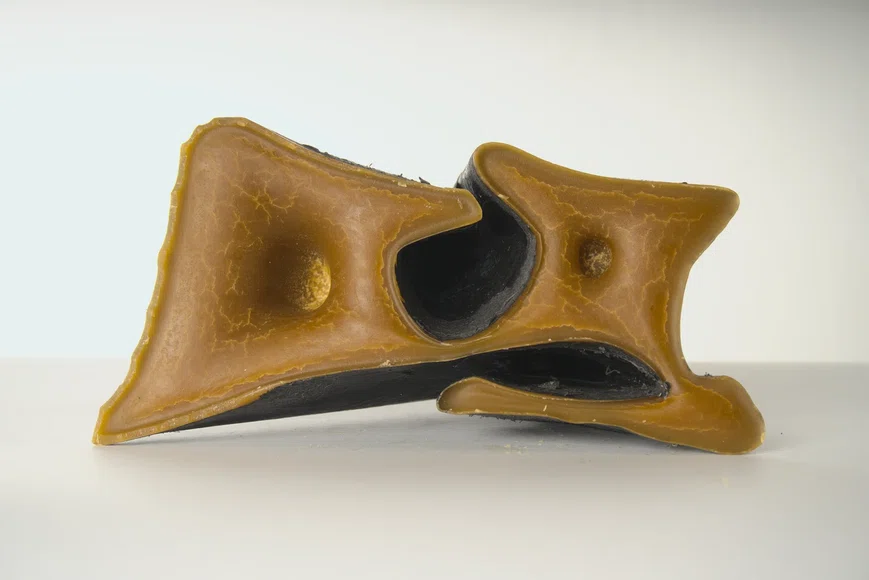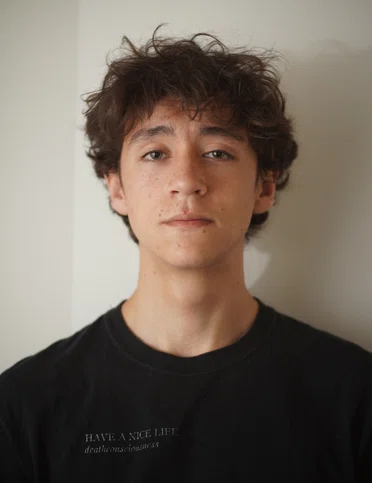





3-D Design
Santiago Abella
Colegio Los Nogales High School|Bogotá, Colombia, South America

Untitled|5 x 8 x 2 in.
Idea(s): Create dynamic structures that capture the effects of moving water, impression on wax.
Material(s): Black card stock, beeswax, water, bucket.
Process(es): Molten wax poured into folded card stock mold, mold placed over bucket being filled with cold water.
Curatorial Note: Student creates movement through abstract wax sculptures. Created rhythmic and balanced compositions.


“Fascinated by the idea of capturing movement, I focused on one medium, so most of my work was done melting wax and creating systems for it to solidify. I created these systems to achieve three objectives: capture movement, suggest movement, and capture the effects of movement.”

Student statement
Student
statement
The AP Art and Design course supports inquiry-based personalized learning in the sustained investigation portfolio component. What strategies helped you find an investigation idea?
When seeking inspiration for my portfolio, I was caught off guard by the lack of ideas, but as I searched for something meaningful that engaged my curiosity, I had the opportunity to visit the Palm Springs Art Museum. While I made my way through the maze of stairs, ramps, and hallways, I came across a long-standing exhibit that showcased mesmerizing glasswork by Masahiro Asaka, Galia Amsel, and other glass artists. These sculptures quickly became guiding stones for my investigation as they challenged previous ideas I had about the elements and principles employed in 3-D Art design. Large and small volumes of glass stood in perfect equilibrium to give way for harmonious compositions, seemingly fragile curves made clear cuts between negative and positive space, and continuous lines danced in dynamic elegance to form rhythmic structures. In other words, I became fixated on the different ways of suggesting movement in 3-D design. And so, actively consuming art became my prime strategy to find an investigable idea; by studying the work of other artists from a technical standpoint, I found a wealth of complex questions and proposals that gave new life to my artistic endeavor.

Santiago Abella
Leer en español
Declaración
del
estudiante
En el componente de “sustained investigation” el curso AP de arte y diseño apoya un aprendizaje personalizado y basado en la investigación. ¿Qué estrategias te ayudaron a encontrar una idea para investigar?
Buscando inspiración para mi portafolio, fui sorprendido por la falta de ideas, pero mientras buscaba algo significativo que atrajera mi curiosidad, tuve la oportunidad de visitar el museo de arte de Palm Springs. Recorriendo el laberinto de escaleras, rampas y pasillos, me encontré con una de las exhibiciones más viejas del museo, que mostraba las increíbles esculturas de vidrio de Masahiro Asaka, Galia Amsel y otros artistas. Estas esculturas rápidamente se convirtieron en guías para mi investigación, pues retaron las ideas que yo tenía sobre los principios y elementos de la tridimensionalidad. Grandes y pequeñas cantidades de vidrio se paraban en un equilibrio perfecto para permitir una composición armoniosa, curvas aparentemente frágiles hacían cortes limpios entre espacios negativos y positivos, y líneas continuas bailaban en dinámica elegancia para formar estructuras con ritmo. En otras palabras quedé consumido por las diferentes maneras de sugerir movimiento en la tridimensionalidad. Y así, consumir arte se convirtió en mi estrategia principal para encontrar una idea investigable; al estudiar el trabajo de otros y otras artistas desde un punto de vista técnico, encontré una gran cantidad de preguntas y respuestas complejas que le dieron vida a mi exploración artística.
En el componente de “sustained investigation” el curso AP de arte y diseño apoya un aprendizaje personalizado y basado en la investigación. ¿Qué estrategias te ayudaron a encontrar una idea para investigar?
Buscando inspiración para mi portafolio, fui sorprendido por la falta de ideas, pero mientras buscaba algo significativo que atrajera mi curiosidad, tuve la oportunidad de visitar el museo de arte de Palm Springs.

View 2
Teacher Statement
Teacher Statement
William Cruz

Strategies
From the beginning of this class, I try to make all my students aware that any research topic is valid. The most important thing is that whatever it is, it must have a personal approach, that is, it must arise from the interests of each one. We start by proposing three possible topics and working around them, then choose just one.
Write and Reflect
For each of the topics proposed by them, I ask them to do several things: automatic writing for several minutes (from the initial concept without thinking or looking for coherence or structure in what they write, for ideas to flow naturally), to make conceptual maps and to look for definitions of key or interesting concepts.
These maps and texts must be analyzed to find common points, and key and interesting ideas from which they can take advantage. All this will serve to nurture the creation of images.Skill development
Throughout the year, we do several exercises to explore materials and processes, my intention is to push and encourage them to take risks and explore mark-making. Another project that I think contributes a lot in this sense is what I call “do it his way": from a given list of artists, they choose the ones that most appeal to them to develop their own project, using the particular style of that specific artist.
Evaluation
From the beginning of each unit, I share with my students a rubric that will not only be an evaluation tool but will serve as a guide for creation. Its components are: research, content, technique, composition, creativity, and final work (each component has descriptors that illustrate what they must do to meet the standard that the component indicates). These rubrics are used during the critique, self-assessment, and co-assessment processes. It is important to emphasize that something key in this class are the critiques, in which all students participate based on given parameters. Having to talk about their artwork and that of others and listening to what others have to say about theirs greatly enriches the work of each of them.
Santiago
Something special about Santiago's work in this class was that he never cared or was particularly interested in grading. What always moved him was his interest in experimenting, creating, and, above all, learning. This helped him not to be afraid of doing something. I can say that experimentation is the basis of his project.
Support
It is noteworthy the support it has, not only this class, but the arts in general at Los Nogales school. We have a specialized building and all the materials we need. In addition to this, we receive all the support we need to develop the programs that, from the head of the department, we consider useful to support the artistic development of all our students.
Advice
If I had to give one piece of advice to other AP Art and Design teachers, it would be to do everything possible to help each student develop their own voice. That is, to provide the necessary experiences to enrich and make visible those ideas, interests, and particularities that each student has.
Leer en español
Declaración
del
Profesor
Estrategias
Desde el inicio de esta clase, intento hacer conscientes a todos mis alumnos de que cualquier tema de investigación es válido. Lo más importante es que, sea como sea, debe tener un enfoque personal, es decir, debe surgir de los intereses de cada uno. Comenzamos proponiendo tres temas posibles y trabajando en torno a ellos para luego elegimos solo uno.
Escribir y Reflexionar
Para cada uno de los temas propuestos por ellos, les pido que hagan varias cosas: escritura automática durante varios minutos (desde el concepto inicial sin pensar o buscando coherencia o estructura en lo que escriben, esto para facilitar que las ideas fluyan con naturalidad), hacer mapas conceptuales y, buscar definiciones de conceptos clave o interesantes.
Estos mapas y textos deben ser analizados para encontrar puntos en común, e ideas clave e interesantes de las que puedan sacar provecho. Todo esto servirá para nutrir la creación de imágenes.
Desarrollo de Habilidades
A lo largo del año hacemos varios ejercicios para explorar materiales y procesos, mi intención es empujarlos y animarlos a tomar riesgos y explorar la creación sensible. Otro proyecto que creo que aporta mucho en este sentido es lo que yo llamo "a la manera de…": de una lista de artistas dada, ellos eligen a los que más les atraen para desarrollar su propio proyecto, usando el estilo particular de ese artista seleccionado.
Evaluación
Desde el inicio de cada unidad, comparto con mis alumnos una rúbrica, que no solo será una herramienta de evaluación, sino que servirá como guía para la creación. Sus componentes son: investigación, contenido, técnica, composición, creatividad y trabajo final (cada componente tiene descriptores que ilustran lo que deben hacer para cumplir con el estándar que indica el componente). Estas rúbricas se utilizan durante los procesos de crítica, autoevaluación y coevaluación. Es importante recalcar que algo clave en esta clase son las sesiones de críticas, en las que participan todos los alumnos con base en unos parámetros definidos. Tener que hablar de su obra y la de los demás, y escuchar lo que otros tienen que decir sobre la suya, enriquece mucho el trabajo de cada uno de ellos.
Santiago
Algo especial sobre el trabajo de Santiago en esta clase fue que nunca le importó ni estuvo particularmente interesado en sus calificaciones. Lo que siempre le movió fue su interés por experimentar, crear y, sobre todo, por aprender. Esto le ayudó a no tener miedo de hacer. Puedo decir que la experimentación es la base de su proyecto.
Apoyo
Es de destacar el apoyo que tiene, no solo esta clase, sino las artes en general en el Colegio Los Nogales. Contamos con un edificio especializado, y todos los materiales que necesitamos, además de esto, recibimos todo el apoyo necesario para desarrollar los programas que, desde la jefatura de departamento, consideramos útiles para apoyar el desarrollo artístico de todos nuestros alumnos .
Consejo
Si tuviera que dar un consejo a otros profesores de la clase de AP de arte y diseño, este sería hacer todo lo posible para ayudar a cada estudiante a desarrollar su propia voz. Es decir, brindar las experiencias necesarias para enriquecer y visibilizar aquellas ideas, intereses y particularidades que tiene cada alumno.
Estrategias
Desde el inicio de esta clase, intento hacer conscientes a todos mis alumnos de que cualquier tema de investigación es válido. Lo más importante es que, sea como sea, debe tener un enfoque personal, es decir, debe surgir de los intereses de cada uno. Comenzamos proponiendo tres temas posibles y trabajando en torno a ellos para luego elegimos solo uno.


Santiago Abella
















